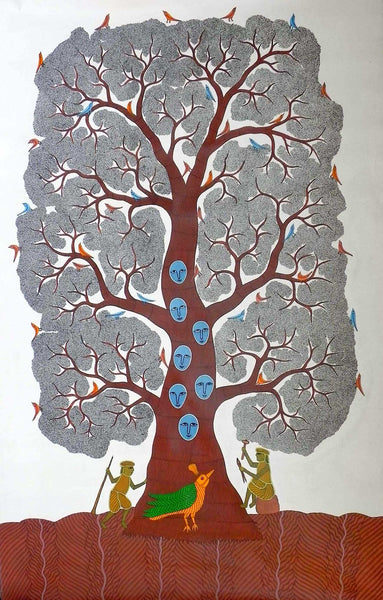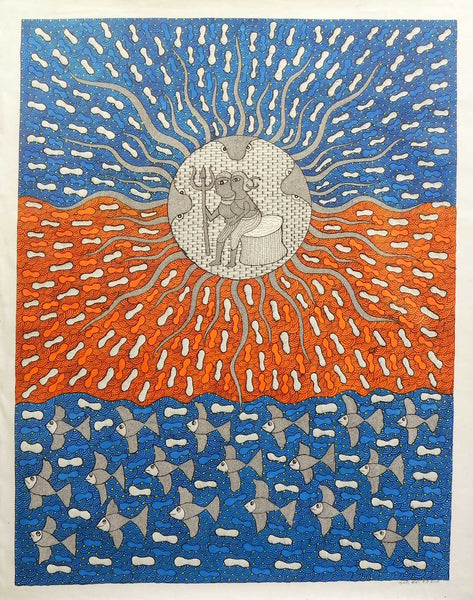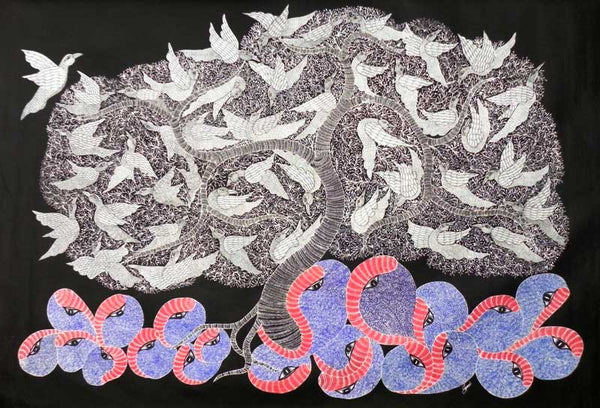Gond Paintings - Capturing the Life and Essence of One of India's Largest Tribes
An age-old tradition that goes back hundreds of years, tribal art in India beautifully captures the lives of some of the earliest inhabitants of our country. Among these, Gond Art – the unique art form of the Gonds, one of the largest tribes in Central India, specifically in Madhya Pradesh, truly encapsulates the essence of tribal art.
 (Gond Painting; Image Source: isha.sadhguru.org)
(Gond Painting; Image Source: isha.sadhguru.org)
 (A Gond artist with a typical Gond artwork. Image source: gaatha.com)
(A Gond artist with a typical Gond artwork. Image source: gaatha.com)
 (Traditional Gond paintings on the walls of the Tribal Museum in Kanha, Madhya Pradesh. Image source: infinityresorts.com)
(Traditional Gond paintings on the walls of the Tribal Museum in Kanha, Madhya Pradesh. Image source: infinityresorts.com)
Like most other tribal art, Gond art is rooted in folk tales and culture. Gond paintings depict almost every aspect of the tribe's lives. Local flora, fauna, Gods and Goddesses, celebrations, festivals, folk-tales and myths are all represented through their art, making story-telling a strong element in their paintings.
 (A painting by Gond artist Durga Bai)
(A painting by Gond artist Durga Bai)
 (A painting by Bhajju Shyam, based on a Gond folktale)
(A painting by Bhajju Shyam, based on a Gond folktale)
Gond art is believed to be an offering in worship of nature, based on the Gond belief that a good image ushers in good luck and helps ward off evil. The art form is characterized by an imaginative use of lines and dots, highlighting a sense of balance and symmetry. The paintings are bright and colourful, painted with natural colours derived from charcoal, soil, plant sap, leaves and cow dung.
 (Painting by Gond artist Venkat Raman Singh Shyam)
(Painting by Gond artist Venkat Raman Singh Shyam)
 (A Gond artwork by artist Suresh Kumar Dhurve)
(A Gond artwork by artist Suresh Kumar Dhurve)
Though Gond art has been around for hundreds of years, it was only in the 1980's that the art form gained much-deserved recognition and fame, through the discovery of Jangarh Singh Shyam, a Gond farmer and artist whose artworks received international acclaim and took him to New Delhi, New York, Paris and Tokyo for exhibitions and shows.
 (Jangarh Singh Shyam (centre) with wife Nankusiya, and Indian painter J. Swaminathan. Image source: aaa.org.hk)
(Jangarh Singh Shyam (centre) with wife Nankusiya, and Indian painter J. Swaminathan. Image source: aaa.org.hk)
Shyam’s artistic brilliance was renowned. He was the first Gond artist to use acrylic on paper and canvas for his paintings, creating the school which is now known as ‘Jangarh Kalam’. His 1988 creation, Landscape with Spider, sold for $31,250 at a 2010 Sotheby's auction, the first for an Adivasi artist.
 (Landscape with Spider by Jangarh Singh Shyam, 1988. Image source: Sotheby's)
(Landscape with Spider by Jangarh Singh Shyam, 1988. Image source: Sotheby's)
 (The interiors of the Madhya Pradesh Vidhan Sabha, painted by Jangarh Singh Shyam. Image source: jangarh-singh-shyam.blogspot.in)
(The interiors of the Madhya Pradesh Vidhan Sabha, painted by Jangarh Singh Shyam. Image source: jangarh-singh-shyam.blogspot.in)
Today, the late artist’s immediate and extended family members are renowned Gond artists themselves. Though trained by Jangarh Singh Shyam, each of these artists – Nankusiya Shyam (his wife), Japani Shyam and Mayank Shyam (his children) and other family members such as Venkat Singh Shyam, Subhash Vyam, Bhajju Shyam and Durga Bai, have their own distinct artistic styles, striving to keep their traditions alive.
 ('Swarn Hiran' by Nankusiya Shyam, wife of Jangarh Singh Shyam)
('Swarn Hiran' by Nankusiya Shyam, wife of Jangarh Singh Shyam)
 (Gond painting by Jangarh Singh Shyam's daughter, Japani Shyam)
(Gond painting by Jangarh Singh Shyam's daughter, Japani Shyam)
 (An artwork by renowned Gond artist Subhash Vyam)
(An artwork by renowned Gond artist Subhash Vyam)
 (Sukhnandi Vyam Pardhan, nephew of Jangarh Singh Shyam, using acrylics on canvas to create a Gond painting. Source: Mid Day)
(Sukhnandi Vyam Pardhan, nephew of Jangarh Singh Shyam, using acrylics on canvas to create a Gond painting. Source: Mid Day)
Traditional, aesthetic and mysterious, the ethos of Gond art lies in its ability to express the language of the tribe’s soul on walls, canvas or paper, making this ancient art form a true reflection of India’s rich artistic heritage.
























































































